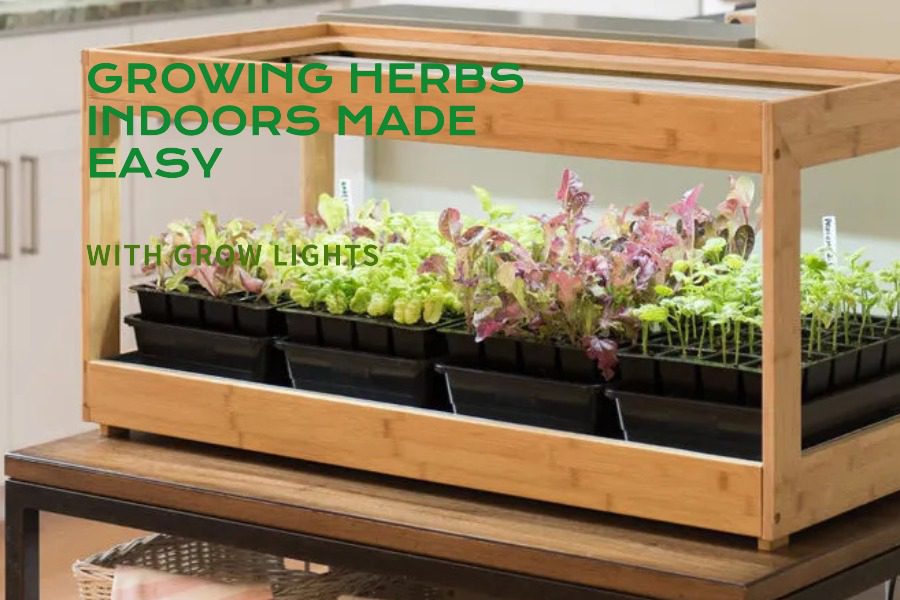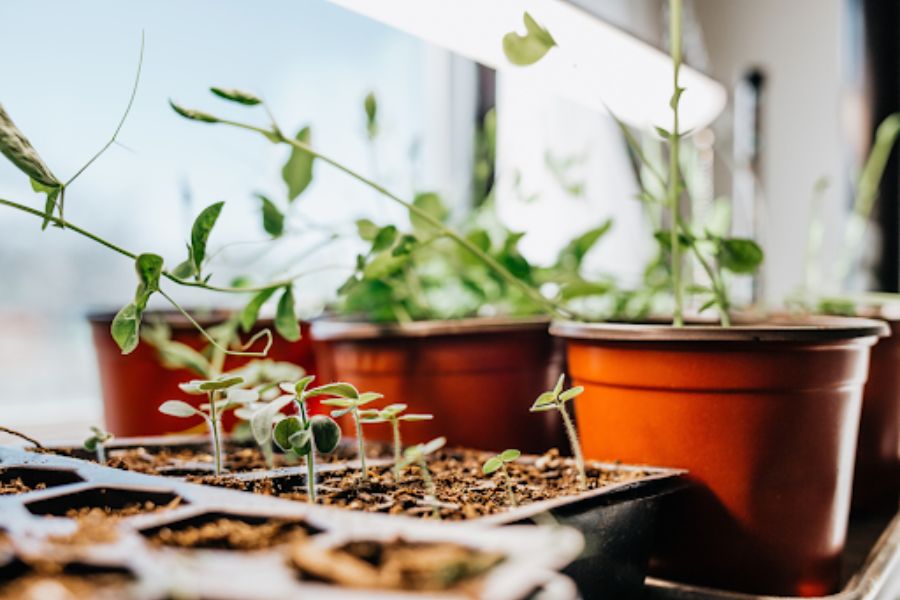Sign up for our newsletter
Get Swipe Garden's independent reviews, and expert advice sent straight to your inbox.
For information privacy practices, read our Privacy Policy.
Sign up for our newsletter
Get Swipe Garden's independent reviews, and expert advice sent straight to your inbox.
For information privacy practices, read our Privacy Policy.
Sign up for our newsletter
Get Swipe Garden's independent reviews, and expert advice sent straight to your inbox.
For information privacy practices, please read our Privacy Policy.

Are you looking for a way to grow fresh herbs indoors, even if you don’t have a lot of natural light? If so, then you’ll need to use grow lights. Grow lights provide the artificial light that herbs need to grow and thrive.
In this article, we will discuss how to grow herbs indoors with grow lights. We will cover everything from choosing the right lights to caring for your plants.
A general tip is to give plants about 12 hours of light per day, but this can vary depending on the plant. For example, when I plant between basil and coriander, basil takes up to 18 hours to grow while coriander will not grow well if it lasts more than 10-11 hours.
Besides, some things to keep in mind before planting, you should choose a suitable place to place the tree so that it is convenient for hanging lights, and the plant can receive the right amount of sunlight and is easy to water. I will often choose places near a window or near an electrical outlet for convenience in planting. Here are detailed instructions for you to easily follow:

There are some popular herbs for beginners such as basil, mint, parsley, chives, thyme, and more to choose. Moreover, you also consider their condition requirements including sunlight, water, and soil.
In this step, I usually determine the right lights to help the plant grow. I recently visited my Swipe Garden and found a range of options available, including LED lights, fluorescent lights, and high-intensity discharge lights. I tested all 3 types of lights and found that LED or fluorescent lights help plants grow healthier.
Then you determine where to place the grow lights for the herb plants. Make sure your location has an electrical outlet to set up the lighting system. You continue to measure the distance between the device and the plant and make sure the distance between the light and the top of the plant is no more than 12 inches.
During the hanging process, I think you should use a hook and follow the manufacturer’s instructions or watch more videos on YouTube to make sure your lamp does not fall and is hung properly.
Besides, it’s often difficult for me to estimate the length of time it takes to prevent the plant from receiving too much light. To solve the above problem, I use a timer to automatically turn on/off and check and monitor the appropriate amount of light for each specific type of herb plant to adjust.
As mentioned, herbs have different needs for sunlight, water, soil, and fertilizer, and also take varying amounts of time to grow. Therefore, you place each type of herb in a separate container to make it easier to move and water them.
It would help if you chose a container that is at least 6 inches in diameter and deep. If you’re starting with seeds, plant a small amount initially and transfer them to a larger pot as they grow.
You need to pay attention to drainage because when planting I realized that herbs do not grow well and die when there is too much water. To avoid the above situation, I often line the bottom with a plate or tray to retain moisture for the plant.
Note: Terra-cotta containers are preferable to plastic or ceramic because they are porous and allow for better moisture retention.
For herbs by the window, I often use a high-quality organic potting mix, ensuring a balance between good drainage and moderate moisture retention.
For indoor plants, the potting mix should be airy, moist, and well-drained. Moreover, a soilless mix with peat moss, vermiculite, and perlite is recommended.
Note: Avoid using garden soil as it may contain pests and is too heavy for containers.
First, you put your herb seeds or young plants in your pots and make sure to do it the way the seed package or plant tag says. Give them a good soak of water right after you put them in. Next, keep the soils damp, but not super wet, as you go forward. Once a month, you also add some all-purpose plant food to help them grow better.
Over time, you should turn your plants around every seven days so all sides get enough light. Moreover, watch out for bugs or sick plants and fix those problems right away.
You need to cut some herbs to help the plants grow more leaves and stay full. Also, cut your plants to stop them from getting too tall or packed together.
Here are some tips to keep in mind when caring for herbs indoors with grow bulbs:
The ideal distance for the plant to grow is no more than 12 inches, as it provides enough light without burning the plant. I often use a design that can adjust the height as the plant grows. At first, seedlings may need closer light, while mature plants may need a little more distance.
For example, seedlings may need light up to 6 inches away to help them grow. As the plants mature, move the lights about 12 inches away.
Furthermore, the appropriate distance can also vary depending on the type of grow light. I recommend using LED lights because they can often be placed closer to the plant than High-Intensity Discharge (HID) lights, which generate more heat and should be placed farther away.
For example, if you are using LED lights, you can typically place them 12 to 18 inches above the plants because they don’t get too hot. Meanwhile, High-Intensity Discharge (HID) lights will radiate more heat and should be placed farther away about 24 to 36 inches.

In my experience, there are some plants that won’t need light until they have sprouted. Therefore, when using grow lights for them, you should carefully refer to the instructions on the seed package to consider whether to use lights for them.
In addition, seedlings will need 14 to 16 hours of light per day. You can use a timer to help you balance the time more accurately and make sure the plant gets the right amount of light to grow.
You also need to pay attention to the temperature of your growing environment. Typically, some herbs like basil prefer warm temperatures, which range from about 75°F – 85°F (23°C – 29°C). Meanwhile, other species can thrive in temperatures of 50°F – 75°F (10°C-23°C).
If you have a warm growing space, plants like thyme, basil, and oregano will be suitable. If your home space is cooler, it is suitable for growing plants such as mint, cilantro, chives, parsley, and dill.
First, there are popular grow lights like LED, HID, and fluorescent. But for herbs, it is best to use LED and fluorescent lights because it saves energy and is enough for herbs to grow. Also, I do not choose HID lights because their intensity is too strong and burns the leaves.
Besides, different species of herbs will have different light requirements. Therefore, when choosing a lamp, factors such as capacity, light intensity, and temperature are factors that I think should be considered carefully.
Regarding temperature, compared to other plants, herbs will absorb a lower amount of light, I usually only use 20-50 watts per square foot, with this capacity helping this herb grow. strong development. In addition, I also tested using higher capacity, these plants did not live long or turned yellow.
In terms of light intensity, at least 6000-8000 lumens per square minute is enough. The color temperature of red light (2700K-3000K) and blue light (5000K-6500K) will help plant growth. However, you need to note that depending on the different stages of plant development, choose red or blue light.
For example, the blue light will be good for the vegetative process and the red light will be good for the flowering stage, also the full spectrum will cover both benefits. Depending on the type of herbs you grow, decide on a specific and appropriate color temperature.

Growing herbs indoors with grow lights is a great way to have fresh herbs on hand all year round, even if you live in a climate that doesn’t support outdoor herb gardening. By following the tips in this article, you can easily grow your herbs in your home.
How long can herbs grow better under lights?
Normally, herbs need around 6 to 7 hours of sunlight to grow well. But if you can’t get that much light naturally, consider herbs that need less light, like mint or parsley.
How close should the light be to my basil plant?
For basil, keep the light just 2 to 4 inches away from the plant. If your basil starts to look tall and thin, it probably needs more light.
Which herbs require little light?
Some herbs like arugula, basil, parsley, dill, chervil, cilantro, chives, garlic chives, watercress, and alpine strawberries don’t need too much light.